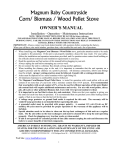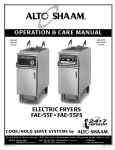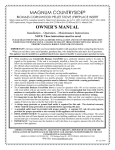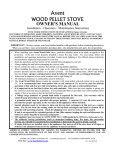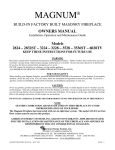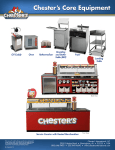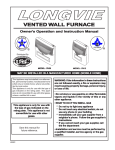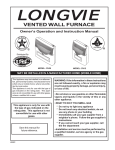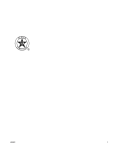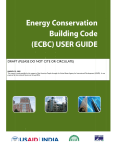Download American Energy Systems T-40 AC Operating instructions
Transcript
AMERICAN ENERGY SYSTEMS, INC. OWNER’S INSTALLATION AND OPERATION MANUAL FOR PELLET FUEL BURNING HEATER Save these instructions MODEL T-40 DC SAFETY NOTICE Please read this entire manual before you install and use your new stove. For your safety, follow the installation directions. If your stove is not properly installed a house fire may result. Contact your local building or fire officials about restrictions, installation inspection and requirements in your area. Failure to follow instructions may result in property damage, bodily injury or death. American Energy Systems, Inc. A FAMILY OF HEARTH PRODUCTS www.hearthdirect.com 150 MICHIGAN STREET SE HUTCHINSON MN 55350 (320) 587-6565 FAX (320) 587-8872 SECTION PAGE Introduction……………………………………………………… 1 Automatic Features……………………………………………… 2 Safety Warnings…………………………………………………. 3, 4 Installation Precautions………………………………………….. 5 Mobile Home Requirements…………………………………….. 6 Clearances……………………………………………………….. 7 Vent Termination Instructions…………………………………… 8 Horizontal Installation…………………………………………… 9 Vertical Installation………………………………………………. 10 Control Panel/Thermostat Hook-up………………………………. 11 Optional 12 Volt System Installation……………………………… 12 Operating Instructions……………………………………………... 13, 14 Cleaning Instructions……………………………………………… 15, 16, 17 Wiring Diagram……………………………………………………. 18 Replacement Parts List…………………………………………….. 19 Warranty……………………………………………………………. 19 INTRODUCTION This stove has been independently tested in accordance with ASTM 1509 Tested with OMNI ENVIRONMENTAL SERVICES, INC., BEAVERTON, OREGON 97005 per EPA Exempt and Underwriter Laboratory Standards. Report No. 097-S-03-2 The pellet fired appliance has been tested and listed for use in manufactured homes in accordance with Oregon Administrative Rules 814-23-900 through 814-23-909 SERIAL #______________ DATE PURCHAED_______________ READ THIS MANUAL THOROUGHLY BEFORE INSTALLING THIS UNIT AND KEEP THIS MANUAL IN A HANDY PLACE FOR FUTURE REFERENCE. (1) AUTOMATIC FEATURES A. THERMOSTAT OPTION: When using a thermostat, set the stove to one of the medium or higher settings. The stove will burn at the rate selected on demand by the thermostat (medium to high). When the room temperature drops below the thermostat setting, the thermostat switch will close, allowing the stove to operate at the medium or higher settings. When the room temperature matches the thermostat setting, the thermostat switch will open, allowing the stove to operate at the low setting. B. THERMOSTAT EQUIPMENT REQUIRED (optional): A low voltage millivolt thermostat that will automatically switch between settings previously selected. Type CL2 thermostat wire-20 AWG, 2 conductors. C. STOVE PRESSURE SENSOR: A blocked flue, a down draft, open door, or failure to clean the 3” exhaust in the stove will cause the pressure switch to shut off the fuel feed. To resume operation, it is necessary to locate the cause and correct it. Restart the stove following the instructions in this manual. D. HIGH TEMP THERMODISK: If the stove overheats, it will shut itself down safely. The stove may not be restarted until it has cooled and the reset button is depressed. (See page 15) E. SELF-IGNITER: Automatically ignites the pellets within 3-5 minutes, without the use of fire starter. The igniter will continue to run for approximately 10 minutes until a fire is established. F. PROOF OF FIRE THERMODISK: If the temperature required by the PROOF OF FIRE thermodisk is not high enough within the 10 minute cycle, the auger will stop feeding pellets. G. COOL DOWN SENSOR: After the power switch has been moved to the “OFF” position, the blowers will continue to run for approximately 15 minutes. The cool down sensor will allow the stove to cool down and then automatically shut itself off. If the hopper runs out of pellets and the stove cools off, the auger will stop feeding. However, the blowers will continue to run until the power switch has been moved to the “OFF” position. H. 12 VOLT BATTERY BACK-UP: T-40 DC Pellet Stoves are designed to operate on a 12 volt DC battery for extended back-up periods. This system may be used in conjunction with 12 volt solar systems. When used with a solar panel, refer to the wiring diagram in this manual. (2) SAFETY WARNINGS If this stove is not properly installed, operated and maintained, a serious house fire may result. Always follow the recommended clearances to combustibles for this stove and the stove chimney. This appliance is designed specifically for the use of palletized wood. Never place wood, paper, furniture, drapes or other combustibles near the stove. Do not install this stove in locations where gasoline, kerosene, charcoal lighter fluid, paint thinner or any other flammable liquid is stored or used. CAUTION: DO NOT USE FLAMMABLE LIQUIDS TO START OR “FRESHEN UP” A FIRE IN THIS STOVE. The floor must be non-combustible or otherwise protected by a non-combustible floor protector. Follow the instructions in this manual for size and type of floor protection required. If installing this stove in conjunction with a masonry chimney, be sure the chimney is in good condition and meets the minimum standards of the National Fire Protection Association (NFPA) Standard 211. Special methods are required when passing a connector through a wall, or when passing a chimney through a ceiling or wall. Follow the chimney manufacturer’s instructions and local building codes. If installing this stove with a pre-fabricated listed metal chimney, the chimney must be one of the types listed in this manual. The chimney or chimney liner must be inspected and cleaned regularly to avoid excessive creosote and soot build-up. Failure to do so can result in a serious chimney fire which may damage the chimney and/or cause a house fire. Repair and replacement of any part of this stove must be done by a trained technician unless instructions are given in this manual. DISCONNECT THE POWER CORD BEFORE ANY REPAIRS OR CLEANING. Never place the power cord so that it is under or in front of the stove. Never cut or remove the grounding prong from the power cord plug. Do not use an adaptor plug. The stove will not operate unless connected to a power source of 120V, 60HZ and must be properly grounded. The stove is suitable for use in mobile homes. Read and follow the specific installation instructions in this manual when installing in a mobile home. This stove is not to be connected to any air distribution duct. The appliance must be vented only to the outside. Never vent the appliance to other rooms or buildings. THE VIEWING DOOR AND HOPPER DOOR MUST BE CLOSED AND/ OR LATCHED DURING OPERATION. SAFETY WARNINGS…CONTINUED FIRE EXTINGUISHER: Every home should have at least one fire extinguisher. An approved “class a-b-c” extinguisher should be mounted on the wall near an exit and close to the appliance, but not so close that accessibility to the extinguisher could be blocked by a fire. Your local fire department can advise you concerning the most appropriate location. BUILDIING AND FIRE CODES, PERMITS AND INSPECTIONS: The installation of this pellet appliance must comply with your local building and fire codes. Always contact your local building inspector and/or fire department before beginning the installation process. If required, obtain a permit before installation and have the completed installation inspected. Remember that not complying with building and/or fire codes may jeopardize your homeowner’s insurance. CHILDREN: Do not allow children to play near the appliance or with the controls. Severe burns may be inflicted by touching the door or glass, the front, sides or top of the appliance. Train children to stay away from the appliance, and never leave children unattended in the room when the appliance is in operation. SMOKE DETECTORS AND CARBON MONOXIDE DETECTORS: Install at least one smoke detector and carbon monoxide detector on each floor of your home to ensure your safety. They should be located away from the pellet appliance and close to the sleeping areas. Follow the smoke detector and carbon monoxide manufacturer’s placement instruction and maintenance instructions. Your local fire department may provide assistance in selecting smoke detectors and carbon monoxide detectors, or contact the Consumer Product Safety Commission, Washington, DC 20207. The appliance area must be kept clear from combustible materials, gasoline and other flammable vapors and liquids. (4) INSTALLATION PRECAUTIONS CAUTION: Do not install this appliance in any manner other than as described in this manual. If you have any questions about properly venting or installing your Reliant pellet stove, please contact your dealer or American Energy Systems, Inc. for information. NOTE: THIS STOVE MUST BE BURN TESTED OUTSIDE IN A WELL VENTILATED AREA FOR AT LEAST ONE HOUR. THIS WILL CURE THE PAINT AND SEASON THE STOVE METAL. SMOKING AND STEAMING IS NORMAL DURING THE CURING PROCESS, AND MAY CONTINUE DURING THE FIRST FEW TIMES THE STOVE IS USED. The ONLY authorized exhaust vent pipe for this appliance is 3 inch listed Type PL pellet vent pipe, designed for use with pellet stoves. This stove may be connected to an existing factorybuilt chimney using pellet vent pipe as a connector, and a 3-4”, 3-6”, or 3-8” PELLET VENT to CHIMNEY ADAPTERS. Follow the pellet vent pipe manufacture’s instructions for the installation of the vent pipe being used. (See “Existing Vertical Installation” on page 10). As you plan your installation, consider the following: - The stove should be placed as central in the home as possible. Consider safety, convenience, traffic flow and the fact that the stove will need a venting system. - Before drilling or cutting holes, select the location of the appliance. Determine where the ceiling rafters, wall studs or floor joists are located before making any large holes as the appliance may have to be moved. - Care must be taken to maintain minimum clearances to combustibles as per local building codes, fire codes, and the safety listing tag on the inside hopper lid. - An outside air source must be connected to the stove and can be brought in through the sidewall or vented crawl space. Flexible or rigid pipe should be used and will connect to the adaptor on the back of the stove. (See air inlet location under the CLEARANCE section of this manual) DO NOT CONNECT THIS STOVE TO A CHIMNEY FLUE SERVING ANOTHER APPIANCE. DO NOT USE SINGLE WALL PIPE FOR ANY INSTALLATION. DO NOT INSTALL A FLUE DAMPER IN THE EXHAUST VENTING SYSTEM OF THIS UNIT. THIS EXHAUST SYSTEM IS PRESSURIZED. Electrical power is 120-60hz. (See page 12 for optional 12 volt battery backup.) The stove is provided with a six foot grounded electrical cord, and should be connected to a standard 3 prong 120 volt, 60hz electrical outlet. Do not route the cord in front of, or under the stove. NOTE: A MAJOR CAUSE OF VENT RELATED FIRES IS FAILURE TO MAINTAIN REQUIRED CLEARANCES (AIR SPACES) TO COMBUSTIBLE MATERIAL. PLEASE FOLLOW THE VENT PIPE MANUFACTURERS INSTRUCTIONS AND LOCAL BUILDING CODES FOR THE PROPER CLEARANCES TO COMBUSTIBLES REQURED FOR THE INSTALLATION OF THE VENT PIPE BEING USED. (5) MOBILE HOME REQUIREMENTS SPECIAL MOBILE HOME REQUIREMENTS: WARNING: DO NOT INSTALL IN A SLEEPING ROOM. An outside air source must be connected to the stove and can be brought in through the sidewall or vented crawl space. Flexible or rigid pipe should be used and will connect to the adaptor on the back of the stoves. (See air inlet location below). CAUTION: When installing the stove in a mobile home, care must be taken not to interfere with the structural integrity of the mobile home. Floor, wall and ceiling/roof integrity must be maintained. When installed in a mobile home, this appliance must be grounded to the steel chassis of the frame with 12 gauge or larger diameter wire. This appliance must also be bolted to the floor in compliance with and according to H.U.D. requirements, unless not required by local authority. The pedestal model comes with a hole pre-drilled in the base for bolting. The leg model requires a pre-drilled mounting bracket. Connect one end of the bracket to one of the back legs using the same bolt used to fasten the leg to the stove. Secure the other end to the floor. (See diagram below) (Mounting bracket ref. #DV 315) REAR VIEW WITH PEDESTAL REAR VIEW WITH LEGS ___________________________________________________________________ Outside air can be drawn through the floor or through the sidewall. (6) CLEARANCES CONVENTIONAL CLEARANCES A…SIDEWALL B…BACK WALL 9 In. (229 mm) 3 In. (75 mm)……(VERTICAL VENTING INSTALLATION REQUIRES A MIN. 3” CLEARANCE FROM COMBUSTIBLES TO VENT PIPE). C…CORNER WALL 3 In (75 mm)…….(VERTICAL VENTING INSTALLATION REQUIRES A MIN. 3” CLEARNACE FROM COMBUSTIBLES TO VENT PIPE). D…VENT PIPE TO WALL 3 In (75 mm)……..(MAINTAIN 3” INCH CLEARNACE FOR ALL INSTALLATIONS) E…FLOOR PROTECTION FRONT F…FLOOR PROTECTION SIDES 6 In (150 mm) 6 In (150 mm) HORIZONTAL INSTALLATION FLOOR PROTECTION Floor protection must be 3/8” inch Minimum thickness non-combustible Material or equivalent extending Beneath heater and to the front/side/rear As indicated. - Sides of the stove to the front of the grill openings must have a 9” inch clearance. VERTICAL INSTALLATION CHIMNEY AND CONNECTOR: 3” LISTED PELLET VENT ONLY NOTE: REGARDLESS OF STOVE CLEARANCE, VENT PIPE MUST ALWAYS HAVE A 3” INCH CLEARANCE. ALCOVE CLEARANCES MIN. ALCOVE WIDTH MIN. ALCOVE HEIGHT MAX. ALCOVE DEPTH MAX. ALCOVE DEPTH 41 In. (1054 mm) 47 In. (1194 mm) 36 In. (914 mm) 36 In. (914 mm) WARNING: THE MINIMUM CLEARNACES LISTED ABOVE ARE BASED ON 3” INCH PL LISTED PELLET VENT PIPE. IF YOUR APPIANCE IS NOT PROPERLY INSTALLED A HOUSE FIRE MAY RESULT. PLEASE FOLLOW THE PIPE MANUFACTURERS INSTRUCTIONS AND LOCAL BUILDING CODES FOR THE CLEARANCE TO COMBUSTIBLES REQUIRED FOR THE INSTALLATION OF THE VENT PIPE BEING USED. (7) VENT TERMINATION INSTRUCTIONS NOTE: The following are general instructions for installing this appliance. THE VENT PIPE MANUFACTURER’S INSTRUCTIONS SHOULD BE FOLLOWED FOR THE VENT PIPE BEING USED. USE ONLY 3 INCH LISTED TYPE PL PELLET VENT PIPE. WARNING: Shut off all electrical power to the wall or room where the appliance is going to be installed before cutting any holes. Be careful not to drill or cut into any water lines or electrical wiring as water damage or electrical fire may result. Upon determining the best location for your new appliance, maintain at least the minimum allowable clearances. Line up a plumb bob to the flue collar on the stove with the location for the hole in the wall or ceiling before drilling or cutting any holes. (See rear exhaust and air inlet locations under the CLEARANCE section of this manual) Prepare the vent pipe for painting by wiping down with straight vinegar. Rinse vinegar off with clean water and allow the pipe to dry. Use a high temperature paint as directed by the manufacturer (the standard paint is model #6201 charcoal stove-brite). Drill and enlarge the hole as required for installation of the vent pipe and components per the pipe manufacturer’s instructions. Connect the pipe and lock the joints as directed by the pipe manufacturer, and secure the vent pipe to the flue collar on the back of the stove. Add a small bead of RTV high temperature silicone around the outside edge of the flue collar prior to securing the vent pipe. Drill and attach the vent pipe to the flue collar with sheet metal screws. Do not terminate the vent in any enclosed or semi-enclosed area, such as a carport, garage, attic, crawl space, under a sun deck or porch, in a narrow walkway or closely fenced area, stairway, covered breezeway, or any other location which can build up a concentration of flue gases. Vent surfaces can become hot enough to cause burns if touched. Non-combustible shielding or guards may be required. NOTE: THE VENT PIPE SHOULD BE INSPECTED FREQUENTLY TO VERIFY THE INTEGRITY OF THE VENTING SYSTEM AND TO INSURE THAT NO OBSTRUCTIONS OR BUILD-UP EXIST WITHIN THE VENT PIPE. FAILURE TO INSPECT THE VENT PIPE CAN CAUSE A MALFUNCTION OR HAZARDOUS OPERATION OF THE STOVE. (8) HORIZONTAL INSTALLATION EXHAUST VENT TERMINATION SHALL BE AS FOLLOWS: A MINIMUM OF 4 FEET/122Omm BELOW, BESIDE AND 1 FOOT ABOVE ANY DOOR OR WINDOW THAT OPENS, OR ANY OPENING INTO A BUILDING. A MINIMUM OF 2 FEET/610mm FROM ANY ADJACENT BUILDING OR OVERHANG. A MINIMUM OF 7 FEET/2130mm ABOVE GRADE, WHEN LOCATED ADJACENT TO PUBLIC WALKWAYS. A MINIMUM OF 2 FEET/610mm ABOVE GRASS, PLANTS OR OTHER COMBUSTIBLES. Note: The pipe lengths shown are for reference only. Your actual pipe length requirements may differ. SINGLE WALL PIPE SHALL NOT BE USED FOR ANY INSTALLATION. HORIZONTAL INSTALLATION SHALL BE A MAXIMUM OF 5’ FEET. WARNING: Vent surfaces can become hot enough to cause burns if touched. Non-combustible shielding may be required. PLEASE FOLLOW THE PIPE MANUFACTURER’S INSTRUCTIONS AND LOCAL BUILDING CODES FOR THE CLEARANCES TO COMBUSIBLES REQUIRED FOR INSTALLATION OF THE VENT PIPE BEING USED. (9) VERTICAL INSTALLATION GUIDELINES ON CONNECTING TO AN EXISTING FACTORY-BUILT CHIMNEY: 1. 2. 3. 4. 5. 6. Inspect the chimney for the presence of creosote, soot or other combustible deposits, and blockage or obstructions. Thoroughly clean the chimney and remove any obstructions. Thoroughly inspect the chimney for soundness, proper clearances and presence of all necessary parts, including a chimney cap, prior to making the connection. This stove may be connected to an existing ceiling-mounted factory-built chimney with a diameter of 4, 6, or 8 inches. Use a 3-4”, 3-6” or 3-8” Pellet Vent to Chimney Adapter provided by the pellet vent manufacturer. Use only listed 3 inch Type PL pellet vent pipe between the stove and the chimney. Follow the pellet vent manufacturer’s instructions to assemble the vent pipe and make the connection to the chimney. EXISTING FACTORY-BUILT CHIMNEY INSTALLATION NEW INSTALLATION NOTE: THE PIPE LENGTHS SHOWN ARE FOR REFERENCE ONLY. YOUR ACTUAL PIPE LENGTHS MAY VARY. SINGLE WALL PIPE SHALL NOT BE USED FOR ANY INSTALLATION. PLEASE FOLLOW THE PIPE MANUFACTURER’S INSTRUCTIONS AND LOCAL BUILDING CODES FOR THE CLEARANCE TO COMBUSTIBLES REQUIRED FOR INSTALLATION OF THE VENT PIPE BEING USED. (10) CONTROL PANEL/THERMOSTAT HOOK-UP WARNING: ALWAYS DISCONNECT POWER CORD DURING ANY ELECTRICAL OPERATION 1. Remove control panel from protective packaging. 2. Connect the one way molex plug to the control panel, do not pull on the wire harness inside the stove. NOTE: Use only a low voltage mercury or bi-metal thermostat switch. (No power Required on thermostat) NOTE: If you are not going to use the thermostat function then skip steps #4 -#8 and got to Step #9. 3. Locate the thermostat on a wall six (6’) to (10’) feet away. 4. Route the wires into the stove near where the AC power cord enters. 5. Pull the thermostat wire through to the control panel cut-out. 6. Move the factory installed jumper from the upper position to the lower position. (see details below) 7. Connect the thermostat wires to the two terminals on the back of the control panel. When the room temperature drops below the thermostat setting, the thermostat switch will close, allowing the stove to operate at the medium or higher settings. When the room temperature matches the thermostat setting, the thermostat switch will open, allowing the stove to operate at the low setting. 8. Locate the control panel into the side panel cut-out and secure with four (4) #7 X ½ Phillips screws (supplied). Do not over tighten. 9. The stove is now ready for operation. Refer to the OPERATING INSTRUCTIONS Note: The thermostat function of the stove will Cycle with the room temperature when the “Fuel Feed Control” is set at a medium or higher setting. (11) OPTIONAL 12 VOLT BATTERY BACK-UP WARNING: ALWAYS DISCONNECT POWER CORD DURING ANY ELECTRICAL OPERATION Note: Never use an unsealed battery 1. Disconnect the 110 volt AC power before connecting the 12 volt battery. 2. Determine the location for the 12 volt battery and obtain the proper length and type of wire (Use 18 gauge stranded wire) 3. Drill and install 1/2” conduit where passing through a wall or floor. 4. Connect a red 18 gauge wire to red positive (+) battery terminal on the stove. 5. Install a 4 amp inline fuse on the red positive wire near the stove. 6. Connect a black 18 gauge wire to black negative (-) battery terminal on the stove. 7. Pass wire through the conduit to battery location. Allow enough wire length between battery box and exterior wall for a drip loop to prevent moisture from reaching terminals. (see diagram) 8. Connect the red positive (+) lead to the positive (+) battery terminal. 9. Connect the black negative (-) lead to the negative (-) battery terminal. 10. Reconnect the 110 volt AC power. The stove is now ready for 12 volt back-up and will switch automatically to 12 volt operation when AC power is lost. When AC power is restored, the stove will automatically switch back to AC power and recharge the battery. NOTE: THE SELF IGNITER WILL NOT START THE STOVE IN THE DC POWER MODE. (12v Battery Back-up) STARTING THE STOVE IN DC POWER MODE (12v Battery Back-up) 1. Clean out and dump the firepot. (See note at top of page 13) 2. Pull the air damper rod out to approximately ¾. 3. Turn the “Fuel Feed Control” to the 3rd position. 4. Open the door and add approved fire starter to ½” of pellets in the firepot and light the fire starter. Once the fire starter is burning freely, close the door. 5. When the pellets are burning well, press the “On/Off” switch to the “On” position. 6. Let the fire continue to build approximately 1 minute, then push the “Start” button. +Denotes Positive -Denotes Negative (12) OPERATING INSTRUCTIONS NOTE: Each time the stove is started, the firepot should be checked for debris and clear air holes. Some pellets will cause the firepot to build up more frequently making it necessary to stir and clean the firepot more often. Do not allow ash to build up underneath the firepot. PRIMING THE AUGER Never leave the stove unattended during priming or start-up. Priming the auger is only required when the unit is new or when the hopper has completely run out of fuel. TO PRIME THE AUGER: A. Load the hopper with pellets. B. Push the “On/Off” switch to the “On” position. C. Press the “Manual Feed” switch until pellets begin to drop into the firepot. When pellets begin to drop regularly, the auger is primed. STARTING YOUR STOVE A. Pull the air damper control rod out to approximately ¾ open. B. Clean out and dump the firepot. (See note at top of page) C. Turn the “Fuel Feed Control” to the 3rd position. D. Press the “On/Off” switch to the “On position. E. Push the “Start” button. This stove is equipped with a self igniter that will start the pellets without the use of fire starter. Pellets will drop into the firepot and ignite in 3-5 minutes. The igniter will continue to run for approximately 10 min. until a fire is established. If a fire is not started within the minimum cycle, the auger will stop feeding. The “Manual Feed” switch allows you to prime the auger And add fuel to the firepot automatically. In normal Operation, this switch is in its center position. (with Exception for “High Fan” override) Do not use this Switch in the “Manual Feed” position under Normal operation, as it could overload the firepot, smother the fire and lead to a dangerous condition. The convection blower speed varies directly with the feed rate. The “High Fan” switch will override the variable fan function. It will set the convection blower to high at any feed rate setting. Note: In case of a power outage or interruption lasting longer than 5 seconds, the “Start” button must be pushed to re-engage the auger. (13) OPERATION INSTRUCTIONS…continued PROPER FUEL This stove is designed and approved to burn pelletized wood fuel only. Do not use any other type of fuel. Factory approved pellets are those ¼” or 5/16” in diameter and not over 1” in total length. Larger pellets will cause the auger to jam or bridge in the pellet hopper. The use of unapproved fuel will void all warranties. Do not burn damp or wet pellets. The stove’s performance depends greatly on the quality of your pellet fuel. Do not use pellets that have: 1. Excess fines-loose material that looks like sawdust or sand. Loading this material into the hopper may eventually jam the auger and prevent the flow of pellets in the hopper compartment. 2. Binders-material used to hold the pellet together. 3. High ash content-avoid pellet brands that immediately smoke up the viewing window and leave a residue in the burn pot. You will be required to clean the ash boxes and vent pipe more frequently. It may be necessary to sample several brands until you find a brand of pellets that will burn properly. RUNNING YOUR STOVE A. After starting the stove, leave it burning on the 3rd setting for at least 10 minutes to allow the stove to heat to operating temperatures. You may then set the desired burn rate by moving the control switch to the desired operating position. B. Select the most efficient burn by adjusting the air damper control rod in or out. An air damper closed too much will produce a lazy and slow flame. Adjusted properly, the flames should be bright and lively. Altitude and fuel types greatly affect the amount of air required. Opening the damper approximately ¼-1/2 will be sufficient for most installations and fuels. The operating temperatures of this unit may vary with the different types or grades of fuel used. TURNING THE STOVE OFF A. Move the power switch to the “Off” position. The fan will continue to run for approximately 15 minutes to let the stove cool down, and then automatically shut itself off. NOTE: IF THIS UNIT RUNS OUT OF PELLETS AND COOLS DOWN, THE AUGER WILL STOP FEEDING. IT WILL BE NECESSARY TO RE-PRIME THE AUGER ANY TIME THE HOPPER EMPTIES. THE BLOWERS WILL CONTINUE TO RUN UNTIL THE POWER SWITCH IS MOVED TO THE “OFF” POSITION. WARNING: DO NOT USE ADDITIONAL GRATES TO SUPPORT THE FUEL. WARNING: Auger jams are the leading cause of stove malfunctions. Jams occur due to foreign objects in the fuel, or more commonly, failure to follow the operating instructions. Most auger jams are preventable by properly priming the auger as required before starting the stove. Keeping the hopper from running out of fuel will help prevent auger jams. IMPORTANT: Selecting the proper combustion air is done by moving the air damper control rod in or out to decrease or increase the air flow (in= closed, out = open). High altitude or high ash fuel may require more air for efficient fuel combustion. The stove should be started with the damper control rod out in the ¾ open position. (14) CLEANING INSTRUCTIONS NOTE: BE SURE THE STOVE IS TURNED OFF, THE POWER CORD IS UNPLUGGED, AND THE UNIT IS COLD BEFORE CLEANING OR SERVICING. RECOMMENDED CLEANING PERIODS: A. The heat exchange tubes in the stove should be cleaned weekly. B. The fire box should be cleaned every 7 to 10 days. C. The interior ash chambers should be inspected and cleaned as needed. D. The chimney pipe and cap should be checked annually for soot buildup. E. Combustion blower should be cleaned as needed. Check as least semiannually. DISPOSAL OF ASHES: Ashes should be placed in a metal container with a tight fitting lid. The closed container of ashes should be placed on a noncombustible floor or on the ground, well away from all combustible materials, pending final disposal. If the ashes are disposed by burial in soil or otherwise locally dispersed, they should be retained in the closed container until all cinders have been thoroughly cooled. WARNING: MANY HOME VACUUM CLEANERS ALLOW ASH TO ESCAPE INTO THE ROOM AIR; HOWEVER, VACUUMING IS RECOMMENDED OCCASIONALLY TO AID IN SEASONAL CLEANING AND KEEP THE UNIT FREE OF EXCESS ASH. DISCARD THE VACUUM BAG AFTER EACH USE ON THE STOVE. I. FIREBOX A. Open the door, sweep or vacuum Out the ash buildup. Remove the Firepot and empty, inspect all air Holes and clean if blocked. Inspect Under the firepot for build up of ash. B. Replace the firepot in the stove. C. Periodically inspect the ash chambers “A”, “B”, and “C” by removing the inspection caps. D. Remove the 3 wingnuts, bracket and brick panels. The ash chambers can be removed from the firewall for a more thorough cleaning. WARNING: Failure to clean the stove is a leading and preventable cause of stove malfunctions. Fuel types and installations may dramatically affect the cleaning intervals required for your stove. Sampling different brands of fuel to find the cleanest burning fuel available in your area can greatly reduce the amount of maintenance required. (15) CLEANING INSTRUCTIONS…continued WARNING: DISCONNECT THE POWER CORD BEFORE CLEANING OR SERVICING THIS UNIT. THE STOVE MUST BE TURNED OFF AND COOLED BEFORE USING THE RAKE HANDLE. ASH RAKE HANDLE II. HEAT EXCHANGER: This stove is designed with a built-in heat exchange tube Rake. The ash handle is located on the front of the stove and is moved backwards and forwards several times to remove the buildup of ash. After cleaning, push the rake handle in until it stops. III. COMBUSTION BLOWER: Over the course of the heating season dust and ash may collect on the blades of the combustion blower. Periodically they should be inspected and vacuumed clean. The combustion blower is accessed by removing the stove’s right side panel and then removing the inspection caps or the exhaust manifold cover (See figure below). Never operate the stove without the inspection cap or manifold cover in place. (16) CLEANING INSTRUCTIONS…continued WARNING: DISCONNECT POWER CORD BEFORE CLEANING OR SERVICING. NOTE: CLEANING INTERVALS MAY VARY GREATLY WITH DIFFERENT BRANDS OF FUEL DUE TO THE ASH CONTENT, MOISTURE, AND MATERIAL COMPOSITION OF DIFFERENT FUELS. INSPECT AND CLEAN EXHAUST SYSTEM FREQUENTLY DAILY WEEKLY MONTHLY ANNUALLY FIREPOT STIRRED EMPTIED FIREBOX CLEANED ASH CHAMBER INSPECTED CLEANED EXCHANGE TUBES CLEANED COMBUSTION FAN CLEANED CONVECTION FAN CLEANED FLUE CLEANED GASKETS INSPECTED DOOR GLASS CLEANED V. CHIMNEY CLEANING: A. B. C. Creosote Formation-Any time wood or a wood product is burned slowly, tar and other bi-products of combustion are produced. These products can condense in a cooled chimney flue and will accumulate over a period of time. It is important to remove these products periodically to eliminate the possibility they will be ignited in the chimney and produce damage to the chimney or even possibly destroy the home. Clean the chimney as often as needed and never go more than a year without a flue cleaning. Soot and Flyash-Formation and Need for Removal-The products of combustion will Contain small particles of flyash. The flyash will collect in the exhaust venting system and restrict the flow of the flue gases. Incomplete combustion, such as occurs during startup, shutdown, or incorrect operation of the room heater will lead to some soot formation which will collect in the exhaust venting system. The exhaust venting system should be inspected at least once every year to determine if cleaning is necessary. Inspection and Removal-The chimney connector and the chimney should be inspected to eliminate the risk of a chimney fire. Check the chimney from both the top and bottom. The creosote should be removed with a brush designed for your chimney. A chimney sweep can perform this service. It is recommended that before each heating season the entire system be professionally inspected, cleaned, and repaired if necessary. (17) WIRING DIAGRAM WARNING: DISCONNECT POWER CORD BEFORE SERVICING THIS UNIT: OPTIONAL SOLAR PANEL CONNECTIONS WARNING: Use a 3 AMP, 50 volt diode on the “+” Positive lead between the solar panel and battery as shown in the diagram below. (18) REPLACEMENT PARTS LIST ITEM QTY P/N DESCRIPTION ITEM QTY P/N DESCRIPTION 1 2 3 4 5 6 7 1 1 1 1 1 1 1 ES 010 ES 020 ES 030 DV 040 ES 050 ES 060 ES 070 8 1 DV 080 16 17 18 19 20 21 22 23 24 25 1 1 1 1 1 1 1 1 1 1 DV 160 DV 170 DV 180 DV 190 DV 200 DV 210 DV 220 DV 230 DV 240 DV 250 Norprene ¼” ID Hose Standard Door Door Handle Assembly Door Glass Glass Gasket Grapho WT-187 Door Gasket Grapho 5/8” Firepot Brick Panel (left side) Brick Panel (right side) Panel Bracket 9 1 DV 090 10 11 12 13 14 15 1 1 1 1 to 3 1 1 DV 100 DV 110 DV 120 DV 130 DV 140 DV 150 Convection Fan Motor DC Combustion Fan Motor DC Auger Motor DC Auger Shaft/Bushing Set ACE Circuit Board Panel DC Wiring Harness DC N/C 200 Manual Reset Auger Thermodisk N/O 150 Auto Reset Proof of Fire Thermodisk N/O 150 Auto Reset Cool Down Thermodisk Ash Chamber “A” (left side) Ash Chamber “B” (right side) Ash Chamber “C” Inspection Caps Pressure Switch .1 Automatic Igniter 1 2 3 Optional Parts List 1 to 4 DV 300 1 to 4 DV 310 1 DV 315 4 5 6 7 1 1 1 1 DV 320 DV 330 DV 340 DV 350 Black Legs Gold Legs Leg Mounting Bracket (Mobile Home Requirements) Gold Door Thermostat Black Grill Gold Grill WARRANTY TERMS AND CONDITIONS OF WARRANTY AMERICAN ENERGY SYSTEMS, INC. This warranty is null and void unless the original purchaser fully completes the warranty card and the card is returned to the manufacturer, American Energy Systems, Inc. within 30 days after the date of purchase. This warranty is not assignable and is only extended to the original purchaser. Materials and workmanship are warranted for a period of five (5) years from the date of purchase. Electrical components, fan, gaskets, auger assembly, and moving parts are warranted for a period of one (1) year from the date of purchase. The warranty does not apply if damage occurs because of accident, improper operation, negligence or misuse, shipping damage after purchase, improper installation, alteration of manufacturer’s setting of components not covered in the operating manual or unauthorized repair. This limited warranty excludes damage caused by normal wear and tear, such as paint discoloration or chipping, worn or torn gaskets, etc. Also excluded is damage to the unit caused by abuse, improper installation, the use of fuel or fuel loads other than specified by the manufacturer or use not set forth in the Owner’s Manual. Also excluded from the warranty: Neoceram (or equivalent) glass, fiberglass gasket material, gold plating and the fire pot. This stove, or any of its parts, will be replaced or repaired at the manufacturer’s option. If the stove becomes defective during the warranty period, contact your local authorized dealer. All liability for any incidental or consequential damages from breach of any written or implied warranties is disclaimed and excluded here from. Some states do not allow the exclusion or limitation of incidental or consequential damages; therefore, the above limitations and/or exclusions may not apply to your warranty. This warranty gives you specific legal rights and you may also have rights which vary from state to state. Attach your receipt to this page for your records. (19)





















